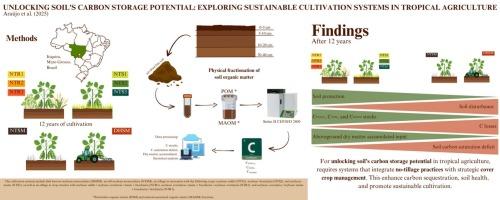Unlocking soil’s carbon storage potential: exploring sustainable cultivation systems in tropical agriculture
IF 5.7
1区 农林科学
Q1 GEOSCIENCES, MULTIDISCIPLINARY
引用次数: 0
Abstract
Rotation and succession with cover crops strategies have been employed to achieve profitability, food security, and adaptation to climate change, which necessarily involves increasing soil organic matter (SOM). This study aimed to evaluate the impact of long-term soybean cropping systems, with and without leguminous and non-leguminous cover crop species, on SOM fractions and their carbon (C) storage capacity in tropical agriculture. We also investigated whether the mere absence of soil disturbance is sufficient to increase soil C stocks and how different cover crop species influence these stocks. The experiment followed a randomized block design with four replications and eight treatments: disk harrow-soybean monoculture (DHSM), no-till-soybean monoculture (NTSM), three crop rotation systems (NTR1, NTR2, NTR3), and three crop succession systems (NTS1, NTS2, NTS3). After 12 years of cultivation, soil samples were collected from the 0–5, 5–10, 10–20, and 20–40 cm layers to determine total organic C (CTOTAL), C in mineral-associated organic matter (CMAOM), C in particulate organic matter (CPOM) fractions, C storage capacity, and C saturation deficit (CSD). Aboveground plant dry matter (DM) input over 12 harvests was also evaluated. Rotation and succession systems increase stocks of CTOTAL, CPOM, and CMAOM compared to DHSM and NTSM. Cover crops contribute to soil C accumulation and eliminating soil disturbance alone (NTSM) is not sufficient to increase C stocks. The CSD indicates that soil management under rotation and succession with cover crops has the potential to function as a C sink and the capacity to continue storing C remains in soils managed under these systems. The accumulation of C through DM on the soil influences C stocks and the CSD. These findings are compatible with and applicable to highly weathered tropical soils. The indicators used in this study (C stocks and CSD) have strong potential for field applicability as tools for managing agricultural soils.

释放土壤碳储存潜力:探索热带农业的可持续耕作系统
采用覆盖作物轮作和演替策略来实现盈利、粮食安全和适应气候变化,这必然涉及土壤有机质(SOM)的增加。本研究旨在评价大豆长期种植制度对热带农业土壤有机质组分及其碳(C)储存能力的影响,包括有无豆科和非豆科覆盖作物。我们还研究了仅仅没有土壤干扰是否足以增加土壤C储量,以及不同覆盖作物物种如何影响这些储量。试验采用随机区组设计,4个重复,8个处理:盘耙-大豆单栽培(DHSM)、免耕-大豆单栽培(NTSM)、3种轮作制度(NTR1、NTR2、NTR3)和3种作物演替制度(NTS1、NTS2、NTS3)。经过12年的栽培,在0-5、5-10、10-20和20-40 cm土层采集土壤样品,测定总有机C (CTOTAL)、矿物伴生有机质(CMAOM)、颗粒有机质(CPOM)组分、C储存量和C饱和亏缺(CSD)。对12个收获期的地上植物干物质(DM)投入进行了评价。与DHSM和NTSM相比,轮作和演替系统增加了CTOTAL、CPOM和CMAOM的储量。覆盖作物有助于土壤碳积累,单靠消除土壤扰动不足以增加土壤碳储量。CSD表明,在覆盖作物轮作和演替的土壤管理下,有潜力发挥碳汇的作用,并有能力在这些系统下管理的土壤中继续储存碳余量。土壤中DM对C的积累影响着土壤中C的储量和CSD。这些发现与高度风化的热带土壤是相容和适用的。本研究使用的指标(C储量和CSD)作为农业土壤管理工具具有很强的应用潜力。
本文章由计算机程序翻译,如有差异,请以英文原文为准。
求助全文
约1分钟内获得全文
求助全文
来源期刊

Catena
环境科学-地球科学综合
CiteScore
10.50
自引率
9.70%
发文量
816
审稿时长
54 days
期刊介绍:
Catena publishes papers describing original field and laboratory investigations and reviews on geoecology and landscape evolution with emphasis on interdisciplinary aspects of soil science, hydrology and geomorphology. It aims to disseminate new knowledge and foster better understanding of the physical environment, of evolutionary sequences that have resulted in past and current landscapes, and of the natural processes that are likely to determine the fate of our terrestrial environment.
Papers within any one of the above topics are welcome provided they are of sufficiently wide interest and relevance.
 求助内容:
求助内容: 应助结果提醒方式:
应助结果提醒方式:


